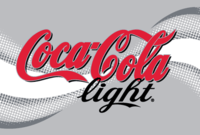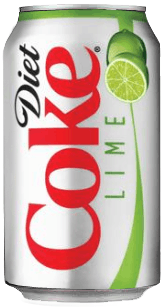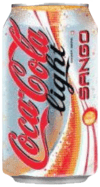Diet Coke
 | |
| Type | Diet Cola |
|---|---|
| Manufacturer | The Coca-Cola Company |
| Country of origin | United States |
| Introduced | 1982, 34 years ago |
| Color | Caramel |
| Variants | |
| Related products |
Coca-Cola Coca-Cola C2 Coca-Cola Zero Tab Pepsi Zero Sugar |

Diet Coke, (called Coca-Cola Light in some countries), is a sugar-free soft drink produced and distributed by The Coca-Cola Company. Unveiled on July 8, 1982[1] and introduced in the United States on August 9,[2] it was the first new brand since 1886 to use the Coca-Cola trademark. The product quickly overtook the company's existing diet cola, Tab, in sales.
History
When Tab was released in 1963, the Coca-Cola Company refused to release a diet soda with the Coca-Cola name, fearing that its flagship brand might suffer. Its rival Pepsi had no such qualms, and after the long-term success of its sugar-free Diet Pepsi (launched in 1964) became clear, Coca-Cola decided to launch a competing sugar-free brand under the Coca-Cola name, which could be marketed more easily than Tab.
Diet Coke does not use a modified form of the Coca-Cola recipe, but instead an entirely different formula. The controversial New Coke, introduced in 1985, used a version of the Diet Coke recipe that contained high fructose corn syrup and had a slightly different balance of ingredients. In 2004, Coca-Cola introduced Coca-Cola C2, which it claims tastes much closer to Coca-Cola but contains half the carbohydrates. In 2005, the company introduced Coca-Cola Zero, a sugar-free variation of regular Coca-Cola.
Diet Coke was sweetened with aspartame, an artificial sweetener, after the sweetener became available in the United States in 1983;[3] to save money, this was originally in a blend with saccharin. After Diet Rite cola advertised its 100 percent use of aspartame, and the manufacturer of NutraSweet (then G. D. Searle & Company) warned that the NutraSweet trademark would not be made available to a blend of sweeteners, Coca-Cola switched the formula to 100 percent NutraSweet. Diet Coke from fountain dispensers still contains some saccharin to extend shelf life.[4]
In 2005, under pressure from retailer Walmart (which was impressed with the popularity of Splenda sweetener), the company released a new formulation called "Diet Coke sweetened with Splenda".[5] Sucralose and acesulfame potassium replace aspartame in this version. Early sales were weaker than anticipated; however, Coca-Cola did little advertising for the brand, investing money and advertising in Coca-Cola Zero instead. By late 2009, some distributors had stopped supplying Diet Coke sweetened with Splenda.
Sales
Diet Coke and Diet Pepsi have capitalized on the markets of people who require low sugar regimens, such as diabetics and people concerned with calorie intake. In the UK, a 330 ml can of Diet Coke contains around 1.3 kilocalories (5 kilojoules) compared to 142 kilocalories (595 kJ) for a regular can of Coca-Cola.
In other countries in which cyclamates are not banned (as they were in the US in 1970[6][7]), Diet Coke or Coca-Cola light may be sweetened with a blend containing cyclamates, aspartame, and acesulfame potassium.
Brand portfolio
| Name | Launched | Discontinued | Notes | Picture |
|---|---|---|---|---|
| Diet Coke | 1982 | The first version of Coca-Cola without sugar |  | |
| Caffeine-Free Diet Coke | 1983 | The first version of caffeine free Diet Coke and the first extension of the Diet Coke formula | ||
| Diet Cherry Coke/Diet Coke Cherry | 1986 | Available in US and United Kingdom (as of 2007). Discontinued in Australia and Israel. |
 | |
| Diet Coke with Lemon | 2001 | 2005 in US | Only available in Austria, Belgium, Brazil, Canada, Bosnia and Herzegovina, Germany, Hong Kong, Japan,[8] The Netherlands, South Africa, Spain, Israel, and the United States. The version sold in Continental Europe uses the Coca-Cola light brand. Was available for a time in Australia. Only available in the United States from Coca-Cola Freestyle machines. |  |
| Diet Vanilla Coke/Diet Coke Vanilla | 2002 | 2005 in US | Only available in Hong Kong, New Zealand (only 300mL and 600mL), Australia, Belgium, Canada and Bosnia and Herzegovina. Only available in the United States from Coca-Cola Freestyle machines. |  |
| Diet Coke with Lime/Diet Coke Lime | 2004 | Available in the US, the UK, Ireland, Finland, Canada and Bosnia and Herzegovina. Was available for a time in Australia. |  | |
| Diet Raspberry Coke | June 1, 2005 | 2006 | Only Available in New Zealand, and Bosnia and Herzegovina. Only available in the United States from Coca-Cola Freestyle machines. |  |
| Diet Coke Sweetened with Splenda | 2005 | Sweetened with Splenda. Diet Coke with Splenda contains 2.83 mgs of caffeine per fluid ounce. The drink contains acesulfame potassium and sucralose; aspartame was used previously as sweetener. |  | |
| Diet Coke Black Cherry Vanilla | 2006 | 2007 | Only available in US and Bosnia and Herzegovina |  |
| Coca-Cola Light Sango | 2005 | Only available in Belgium, France, Luxembourg, and Bosnia and Herzegovina |  | |
| Diet Coke with Citrus Zest | 2007 | Only available in Bosnia and Herzegovina and in the United Kingdom |  | |
| Diet Coke Plus | 2007 | 2011 | Available in many European countries, US and Brazil |  |
Product Timeline
- 1982 – Diet Coke is introduced, becoming the largest-selling low-calorie soft drink in America.
- 1983 – Diet Coke is introduced in the UK.
- 1986 – Diet Cherry Coke is introduced in American markets.
- 1994 – Diet Coke changes logo.
- 1999 – Diet Cherry Coke changes logo.
- 2001 – Diet Coke with Lemon is introduced.
- 2002 – Diet Vanilla Coke is introduced.
- Diet Coke and Diet Cherry Coke change logo.
- 2004 – Diet Coke with Lime is introduced.
- Diet Coke with Lemon changes logo.
- 2005 – Diet Coke sweetened with Splenda is introduced.
- Diet Cherry Coke and Diet Vanilla Coke change logos and are renamed.
- 2006 – Diet Coke Black Cherry Vanilla is introduced.
- Diet Coke with Lemon and Diet Coke Vanilla are discontinued.
- 2007 – Diet Coke Plus is introduced.[9][10]
- Diet Coke Black Cherry Vanilla is discontinued.
- Diet Coke and its six flavors changes logo.
- 2011 – Diet Coke surpasses Pepsi in sales for the first time to become the second most popular soda in the United States after Coca-Cola.[11]
- 2013 – In the UK, Coca-Cola swapped the logo on Coca-Cola, Diet Coke and Coke Zero bottles and cans in the UK with 150 of Britain's most popular names for a summer-long "Share a Coke" campaign.[12][13]
- 2014 – In the US Coca-Cola swapped the logo on Coca-Cola, Diet Coke and Coke Zero bottles and cans in the US with 150 of America's most popular names for a summer-long "Share a Coke" campaign
Advertising slogans
- "Just for the taste of it!" (US 1982)
- "The one of a kind" (US 1984)
- "Just for the taste of it!" (US 1986)
- "Taste it all!" (US 1993)
- "This Is Refreshment" (US 1994)
- "Just for the taste of it!" (US 1995)
- "You are what you drink" (US 1998)
- "Get the taste of it" (US 2000)
- "Live Your Life" (US 2001)
- "Do what feels good" (US 2002)
- "It's a Diet Coke thing" (US 2004)
- "Life is how you take it" (US 2005)
- "Light it up!" (US 2006)
- "Yours" (US 2007)
- "Enjoyment" (US 2007)
- "What life should be like." (US 2008)
- "Just for the taste of it!" (US 2009)
- "Hello You..." (UK 2009)
- "I light it" (Spain 2010)
- "Stay Extraordinary" (US 2010–2014)
- "Love it heavy" (UK 2010)
- "You're On" (US 2014)
- "Just for the taste of it!" (US 2014)
- "Get a Taste." (US 2014–present)
Debate over health issues
The most commonly distributed version of Diet Coke (and the majority of beverages that contain artificial sweeteners) relies on aspartame, which has been suggested to pose health concerns.[14][15] Aspartame is one of the most intensively scrutinized food additives.
Coca-Cola has now released Diet Coke sweetened with sucralose (also known as Splenda), although it is not as common.
The sodium benzoate was found to break down mitochondrial DNA in living yeast cells.[16] Research published in 2007 for the British government's Food Standards Agency suggests that sodium benzoate (E211) is linked to hyperactive behavior and decreased intelligence in children.[17] In January 2008 sodium benzoate was removed from production lines for Diet Coke sold in the UK, however it remains in other Coke products and other production locations.[18]
Coca-Cola Light
According to the Coca-Cola Company, "[t]he sweetener blend used for Diet Coke/Coca-Cola Light is formulated for each country based on consumer preference."[19] Some countries began using the term "Coca-Cola Light" as early as the 1990s, with others adopting the name later on, while others continue the use of "Diet Coke".
Use In Art
Daniel C. Boyer has used Diet Coke to dilute gouache in his paintings.[20]
See also
References
- ↑ "Diet Coke introduced". Wilmington Morning Star. North Carolina. Associated Press. July 9, 1982. p. 6B.
- ↑ "See First Use in Commerce, Trademark Application, US Patent & Trademark Office."
- ↑ "Coke Beginning Aspartame Use". New York Times. August 18, 1983. p. D4.
- ↑ Ordoñez, Franco (March 3, 2005). "Suit Alleges Deceit in Fountain Diet Cola Drinks". Boston Globe. Retrieved August 26, 2008.
- ↑ "Diet Coke Sweetened with Splenda." The Coca-Cola Company. 2009. Web. February 9, 2010.
- ↑ http://www.accessdata.fda.gov
- ↑ Newton, David E (2009-01-01). Food Chemistry. pp. 73–77. ISBN 9781438109756.
- ↑ http://www.sej.co.jp/products/dietcoke1605.html
- ↑ "The Diet Coke Story." Diet Coke. *2010 – The Coca-Cola Company, Web. January 29, 2010.
- ↑ "Cola Marketing History." Solar Navigator. 2008. Max Energy Limited, Web. January 29, 2010.
- ↑ "Top-10 CSD Companies and Brands for 2010" (PDF). John Sicher, Editor & Publisher, Beverage Digest Company L.L.C. Retrieved July 8, 2011.
- ↑ "Coca‑Cola Bottles History". London, UK: Coca-Cola GB. 2013. Retrieved May 28, 2013.
- ↑ "Share a Coke: Is your name on the list?". The Belfast Telegraph. Belfast, UK: Independent News & Media. May 27, 2013. Retrieved May 28, 2013.
- ↑ Nettleton, Jennifer A.; Lutsey, Pamela L.; Wang, Youfa; Lima, João A.; Michos, Erin D.; Jacobs, David R. (2009-04-01). "Diet Soda Intake and Risk of Incident Metabolic Syndrome and Type 2 Diabetes in the Multi-Ethnic Study of Atherosclerosis (MESA)". Diabetes Care. 32 (4): 688–694. doi:10.2337/dc08-1799. ISSN 0149-5992. PMC 2660468
 . PMID 19151203.
. PMID 19151203. - ↑ Maher, T J; Wurtman, R J (1987-11-01). "Possible neurologic effects of aspartame, a widely used food additive.". Environmental Health Perspectives. 75: 53–57. ISSN 0091-6765. PMC 1474447
 . PMID 3319565.
. PMID 3319565. - ↑ Hickman, Martin. "Caution: Some soft drinks may seriously harm your health." November 15, 2011. web.
- ↑ Posch, Linda. "Food Additives, Hyperactivity & Autism Spectrum Disorders (ASD)." Leif Grunseth. October 17, 2007. Web. February 9, 2010.
- ↑ Crowley, Laura (2008-05-27). "Sodium benzoate removed from Diet Coke". Retrieved 2010-05-28.
- ↑ "FAQs". The Coca-Cola Company.
- ↑ "The Adjustment to Silence (after Dawn Stechschulte and Kathy Archambeau)". Retrieved 16 November 2016.
External links
| Wikimedia Commons has media related to Diet Coke. |